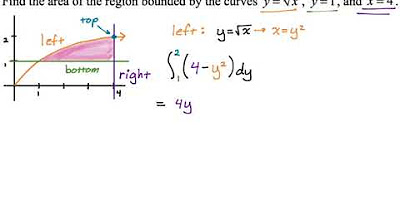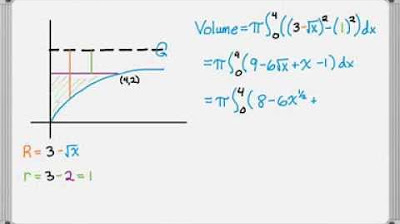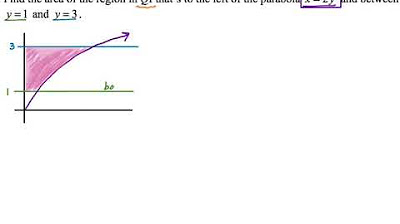Double integrals 6 | Double and triple integrals | Multivariable Calculus | Khan Academy
TLDRIn this instructional video, the presenter delves into the process of evaluating a double integral to find the volume under a surface. The video begins by revisiting the setup of the integral bounds from a previous session. The presenter then demonstrates how to evaluate the integral with respect to x first, by summing up little x sums to form rectangles under the curve. The antiderivative of x*y^2 is calculated, and the process is carried out with respect to y, leading to a final volume calculation. The video also explores an alternative approach by integrating with respect to y first, emphasizing the importance of understanding the bounds and the area of integration. Despite a minor calculation mistake, the presenter corrects it and reaffirms the concept of variable bounds, ultimately arriving at the same volume result, 1/24 cubic units.
Takeaways
- 📚 The video begins with a recap of a previous lesson on calculating volume under a surface using integral bounds.
- 📈 The讲师 demonstrates how to evaluate an integral by visualizing the process as summing up little x sums to form a rectangle.
- 🔄 The first integral is with respect to x, and the讲师 shows the antiderivative of x*y^2 with respect to x is (x^2/2) + constant.
- 🌟 The讲师 emphasizes the importance of correctly evaluating the bounds of the integral, especially when dealing with more complex functions like √y.
- 🎨 The讲师 uses color to differentiate between the integrals and their respective bounds, enhancing the visualization of the problem.
- 🔢 The讲师 makes a mistake in the calculation but corrects it, highlighting the importance of careful calculation in integral problems.
- 📊 The讲师 explains the process of evaluating the antiderivative of y^2/2 - y^3/3, which results in y^3/6 - y^4/12.
- 🔄 The讲师 then approaches the problem from a different angle by integrating with respect to y first, demonstrating an alternative method.
- 📈 The讲师 illustrates the importance of understanding the bounds of integration, especially when they are functions of the variable being integrated.
- 🤔 The讲师 encourages viewers to think critically about the problem, asking questions about the bounds and the process of integration.
- 📝 The讲师 concludes by reiterating that regardless of the order of integration, the volume of the figure remains consistent, reinforcing the concept of mathematical consistency.
Q & A
What was the main topic of the video?
-The main topic of the video was about evaluating a double integral to find the volume under a surface.
How did the video demonstrate the process of integration?
-The video demonstrated the process of integration by first setting up integral bounds and then evaluating the integral with respect to x, forming rectangles, and summing them along the x-axis.
What was the antiderivative of x*y^2 with respect to x?
-The antiderivative of x*y^2 with respect to x is (x^2)/2 + y^2/2, a constant over 2.
How did the video handle the bounds for the integral?
-The video handled the bounds for the integral by evaluating them at the limits of integration, which were x=1 and x=sqrt(y) for the inner integral, and y=0 and y=1 for the outer integral.
What was the final result of the volume calculation?
-The final result of the volume calculation was 1/24 cubic units.
How did the video correct a mistake made during the calculation?
-The video corrected the mistake by revisiting the antiderivative of y^3/3 and correctly identifying it as y^4/8, and then re-evaluating the integral bounds to obtain the correct volume.
What was the significance of visualizing the xy-plane in the video?
-Visualizing the xy-plane was significant because it helped in understanding the region of integration and the bounds more clearly, which is crucial for solving the problem.
What was the method used to evaluate the integral in the second approach?
-In the second approach, the method used to evaluate the integral was to integrate with respect to y first and then with respect to x, starting with the upper and lower bounds for y and then for x.
What was the upper bound for y when integrating with respect to y first?
-The upper bound for y when integrating with respect to y first was y equals x squared, as it was the graph of y=x^2.
How did the video emphasize the importance of careful calculation?
-The video emphasized the importance of careful calculation by pointing out the mistake made during the calculation and correcting it, highlighting the need to avoid such errors to ensure accurate results.
What was the final confirmation of the volume calculation?
-The final confirmation of the volume calculation was that the volume of the figure was 1/24 cubic units, which was consistent regardless of the order of integration.
Outlines
📚 Evaluating Integrals and Volume
This paragraph discusses the process of evaluating integrals to find the volume under a surface. The speaker begins by recalling the setup from the previous video, where integral bounds were established. The focus is on evaluating the integral with respect to x, visualizing the process as summing up little x sums to form a rectangle while holding y constant. The antiderivative of x*y^2 is derived as (x^2)/2 + y^2/2, and the evaluation is demonstrated from x=1 to x=√y. The speaker then transitions to drawing the bounds for the integral in the y direction, which are y=0 to y=1. The evaluation of the double integral leads to the volume of the figure, which is found to be 1/24. The speaker also attempts to correct a mistake made during the calculation, emphasizing the importance of accuracy. Finally, the speaker suggests an alternative approach to the problem by integrating with respect to y first, confirming that the same answer is obtained regardless of the order of integration.
📐 Visualizing Volume with Integrals
In this paragraph, the speaker continues the discussion on calculating the volume of a figure using integrals. The focus shifts to visualizing the problem in two dimensions, emphasizing the importance of understanding the xy plane. The speaker describes the process of summing up small squares (da) to approximate the volume above the shaded region. The height of each square is given by the function x*y^2, and the area of the base is dy*dx. The speaker then identifies the upper and lower bounds for the y and x integration, respectively. The upper bound for y is y=x^2, and the lower bound is y=0. For x, the bounds are x=0 and x=1. The speaker cautions against having variable boundaries in the final sum or integral, as the result must be a fixed number. The calculation proceeds by integrating with respect to y first, leading to the same volume result of 1/24. The speaker concludes by reiterating the importance of careful calculation and visualization in understanding integrals and volumes.
Mindmap
Keywords
💡volume under the surface
💡integral bounds
💡antiderivative
💡rectangles
💡y is equal to x squared
💡summing
💡dy and dx
💡visualize
💡careless mistakes
💡variable boundaries
💡volume calculation
Highlights
The video begins with a recap of the previous discussion on calculating the volume under a surface.
The integral bounds are set up for the volume calculation.
The speaker realizes the utility of scrolling for better visualization and space.
The first integral involves integrating with respect to x, forming rectangles under the curve.
The antiderivative of x*y^2 with respect to x is derived and explained.
The evaluation of the antiderivative from x=1 to x=sqrt(y) is discussed.
The process of evaluating the integral with respect to y is outlined, with y bounds from 0 to 1.
The antiderivative of the function y^2/2 - y^3/3 is calculated.
A mistake is made in the calculation, which is then corrected in the video.
The final volume calculation results in 1/24, which is the volume of the figure.
An alternative approach to the integral calculation is introduced by switching the order of integration.
The upper bound for the y integral is determined by the curve y=x^2.
The lower bound for the y integral is the x-axis, y=0.
The integral is evaluated with respect to y first, confirming the same result is obtained.
The final answer for the volume is derived, which is 1/24.
The importance of visualizing the problem in 2D rather than 3D is emphasized.
The process of summing the rectangles to find the volume above the surface is explained.
The upper and lower bounds on x are identified as 0 and 1, respectively.
The final volume calculation is confirmed to be 1/24, matching the previous result.
Transcripts
Browse More Related Video

Finding a Horizontal Line (y=k) to Divide a Region into Two Equal Parts Using Calculus

Area Between Curves: Integrating with Respect to y (Example 3)

Volume of Revolution Examples - Horizontal Axis

Double integrals 3 | Double and triple integrals | Multivariable Calculus | Khan Academy

Fundamental Theorem of Calculus Explained | Outlier.org

Area Between Curves: Integrating with Respect to y (Example 1)
5.0 / 5 (0 votes)
Thanks for rating: